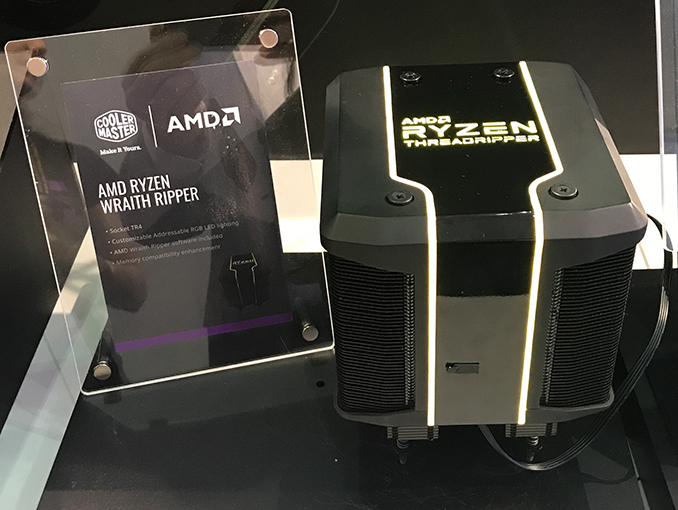AMD Teams Up with Cooler Master for ‘Wraith Ripper' Megacooler
by Anton Shilov on June 20, 2018 2:00 PM EST
One of the important revelations from AMD's recent Ryzen Threadripper 2 announcement wasn't just that the upcomming processors would have more cores - going from 16 to 32 in the case of the top SKUs - but that power consumption would be going up as well. Thankfully unlike the core count it's not doubling, but AMD's official 250W requirement is a good bit higher than Threadripper 1's 180W, and, as a result, Threadripper 2 will be in want of new coolers. To build a cooling system supplied with the new CPUs, AMD teamed up with Cooler Master to product the new cooler. The cooler will be sold separately, through Cooler Master's distribution network.
The Wraith Ripper is a massive megacooler with tens of aluminum fins heatpipes and a fan. Following the recent industrial trends, the cooling system has addressable RGB lighting and a special app for customization. The device will be able to cool down TR4 CPUs that dissipate up to 250 W of power in stock, but heavily-overclocked Threadripper II CPUs will probably require liquid cooling.
Cooler Master says that the Wraith Ripper will not only ensure sufficient cooling for AMD’s 32-core CPUs, but will also guarantee compatibility with memory modules featuring tall heat spreaders.
Pricing of the Wraith Ripper in retail remains to be seen, but users will have to purchase it separately. AMD stated that it will be distributed by Cooler Master and their network, rather than by AMD.
| Want to keep up to date with all of our Computex 2018 Coverage? | ||||||
 Laptops |
 Hardware |
 Chips |
||||
| Follow AnandTech's breaking news here! | ||||||


















35 Comments
View All Comments
niva - Friday, June 22, 2018 - link
I like your insults, my goal for the weekend is to sneak "uncivil twat" into a conversation.mkaibear - Thursday, June 21, 2018 - link
Possible, but unlikely. When you look at the standard deviation of that failure rate you get a reasonable confidence that you'll have at least 27 or so units go bad. It's also perfectly possible you'll get significantly more units go bad...Go study please!
srsly_bro - Thursday, June 21, 2018 - link
Yes, I'm aware the std Dev isn't too far off from 3.4%. I was making the point that it doesn't mean thatThe same % will always fail given a sample size. I don't advocate aio units because of the chance of failure.
close - Thursday, June 21, 2018 - link
BS. You're just here to act like an a-hole and you don't have a leg to stand on.Your point is that the same % won't be valid for any particular sample? Do you know how statistics and probability work? No, it won't be that exact figure for any sample you can think of. But statistically speaking... it is. 34 out of every thousand fail. It might be that you get no failures on your lot of 1000. But for every guy who buys 1000 and has no failures there's another guy who buys 1000 and has 70 fail. And if 70 fail out of your 1000 you'll probably lose a few more since most likely they come from a bad batch that's more prone to failure.
But have it your way. You want a larger sample size? Take 100.000 units and a 3.4% failure rate. That's what...3400 failed units? Maybe under 3000 if you take standard deviation.
You might think it's better for your case? Wrong! It means technically you could end up with 1000 defective units out of 1000.
Bottom line, 3.4% is huge for something that once broken will not only cause hundreds or thousands of $ in physical damage (destroy CPU/MB/GPU/PSU) but also even more expensive loss of data and productivity. That's not something a business is looking for.
ACE76 - Thursday, June 21, 2018 - link
What business will be buying Threadripper CPUs?? This is an enthusiastic product which will mostly ALL be in custom built PCs...your also forgetting that if a leak we're to happen, companies like Corsair will pay for lost components...there's absolutely nothing wrong with using AIO coolers...they offer far better performance than air coolers.69369369 - Thursday, June 21, 2018 - link
>Go study pleaseno u
Fujikoma - Thursday, June 21, 2018 - link
It could also mean that 68 per 1000 fail if that person is unlucky enough to get a bad batch that would average out your imaginary lucky person. It's an average... which 3.4% is excessively high. .00034% might be something a business would be willing to take a risk on, but that depends on the type of clientele and backup systems that are in place. You completely misunderstood the portion on statistical application in the real world.CheapSushi - Thursday, June 21, 2018 - link
Not sure if you're serious about the context. Business or work environments are NOT buying a gigantic RGB LED heatsink. They're most likely NOT even buying Threadripper. And guess what, businesses and datacenters DO use liquid cooling, even Summit, the supercomputer does, often using the OEM of these, Asetek. And also people exaggerating the hell out of the risk of failure on AIC/CLCs. Do you seriously think a company is buying 1,000 systems with the "Wraith Ripper"? Look at the actual post context rather than just spouting bias.mkaibear - Thursday, June 21, 2018 - link
>businesses and datacenters DO use liquid coolingYeah, not off-the-shelf AIOs, though. Custom units installed by the manufacturer and guaranteed to work, coupled with 8- or 4-hour replacement service so that a minimal downtime is incurred, sure - but your average common or garden datacenter won't touch a CLC AIO with a bargepole.
Heatpipe coolers and lots of airflow that's what the majority use.
ACE76 - Thursday, June 21, 2018 - link
Majority of the customers who buy Threadripper or equivalent CPUs use water cooling way more than air cooling.